8th Annual Salary Survey: Satisfaction and stability
Amid some regional and demographic shifts, the compensation picture continues to improve in step with job satisfaction.
Latest Logistics News
USPS cites continued progress in fiscal second quarter earnings despite recording another net loss U.S. rail carload and intermodal volumes are mixed, for week ending May 4, reports AAR New Ryder analysis takes a close look at obstacles in converting to electric vehicles Norfolk Southern shareholders sign off on 10 board of directors nominees Inflation and economic worries are among top supply chain concerns for SMBs More NewsThe results of Modern’s 8th Annual Salary Survey show that veteran materials handling professionals continue to thrive, even as signs begin to emerge of a younger cohort entering the talent pipeline. While businesses work to attract new professionals, they are steadily rewarding those who have been loyal.
At just a few hundred dollars above last year’s record, the average base salary of $98,000 (median $85,000) is the highest in the eight years of our survey. The average of salaries and benefits combined rose 2.2% in 2014, following the nearly 7% jump reported in 2013. In 2015, average overall compensation rose 4.7% and satisfaction is still nearly perfect, including 72% who say they are very or extremely satisfied with their jobs.
Similarly, 93% would recommend the materials handling profession to others. Their efforts might have contributed to an apparent influx of younger respondents. The average age is now 46 years, a significant drop from the 51-year-old average the survey has reflected for at least the previous four years.
There is more good news about the frequency of dramatic cost-saving measures like layoffs and pay cuts, which continue to fall since the highs of 2011. Only one category has increased since then, as this year’s survey shows a slight uptick in the number of respondents who have experienced reduced overtime. Hiring plans also slipped for the first time in years, dropping 1% from last year’s 63% who reported their company added personnel in the prior 12 months. Read last year’s Salary Survey.
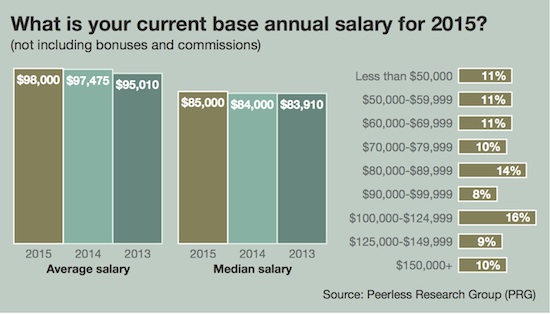
Going forward, 46% of our respondents expect to finish their careers with their current employer, down slightly from 50% last year. About 52% have already been with their employers for 10 years—including 26% who boast more than 20 years of tenure. However, the average turnover rate jumped to 8.7%, having spiked to 7.8% last year after hovering around 6.5% for the previous three years.
The compensation picture
Since the economic recovery, bonuses have been rewarded more for individual performance, and 28% of respondents with bonus or commission plans said those increased by an average of 27%. This marks four consecutive years of bonus increases greater than 20%, and the average bonus now sits at $24,010 (median $5,000).
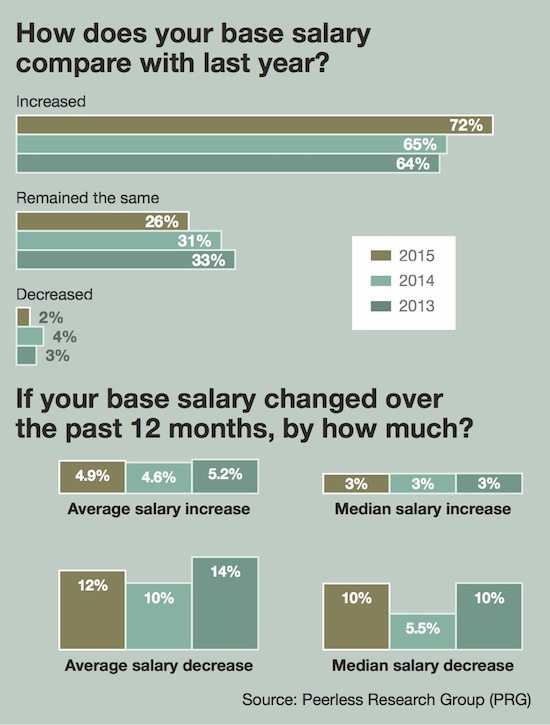
When asked for the factors upon which their bonuses are based, 49% cited personal performance, the highest in the survey’s history and up 4% from 2014. Respondents reported virtually unchanged results for bonuses based on whether the company reaches goals (67%) and increased sales (29%), but rewards for better inventory management dropped by 5% to 10% and lower operational costs were a factor for only 22%, down 4%.
Last year, 65% of respondents said their salary had increased in the previous 12 months, but this year that figure is at 72%. And 2.5%—the lowest since the recession—reported their salaries had decreased, and 5% fewer respondents’ salaries (26%) stayed the same. In 2014, the average base salary increase was 4.6%, dropping below the 5.2% averages of previous years. They have since returned to 4.9% (median 3%). Of those respondents whose salaries increased last year, 17% received increases of 5% to 9%, and nearly one in 10 saw raises of 10% or more.
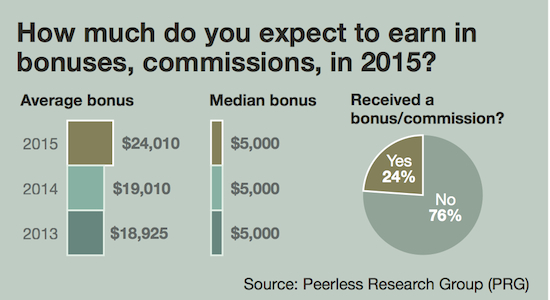
Demographics
About 8.2% of respondents work for companies with estimated 2015 revenues of less than $10 million. Another 20% are at companies between $10 million and $50 million, and nearly half are at one larger than $250 million, including 24% above $2.5 billion.
Respondents represent industries including food, beverage and tobacco (11%); industrial machinery (8%); wholesale trade (7%); retail trade (7%); chemicals and pharmaceuticals (6%); paper and printing (4%); computers and electronics (4%); and transportation and warehousing services (4%). Primary job functions of respondents include warehouse, distribution and logistics (38%); plant management (16%); engineering (19%); company management (9%); and purchasing (8%).
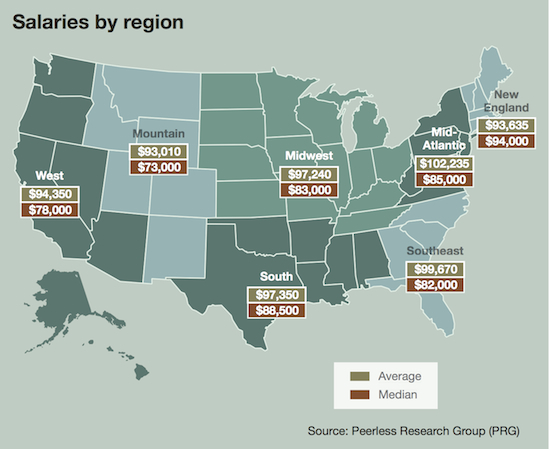
Fewer than 21% of respondents have been in the materials handling profession for less than 10 years, and 58% have been at it for more than 20 years. Last year, the survey indicated 18% of respondents with 30-plus years in the field, a number that has fallen to 13%.
On average, those who have been in the industry less than five years can expect to earn $79,020, up from $71,750 last year. The 2014 survey reflected a 26% growth from the newest cohort to those with 10 to 15 years of experience, but the latter’s average salary has fallen to $82,440. Above the 20-years-of-service mark, the average salary continues to hover around $105,000.
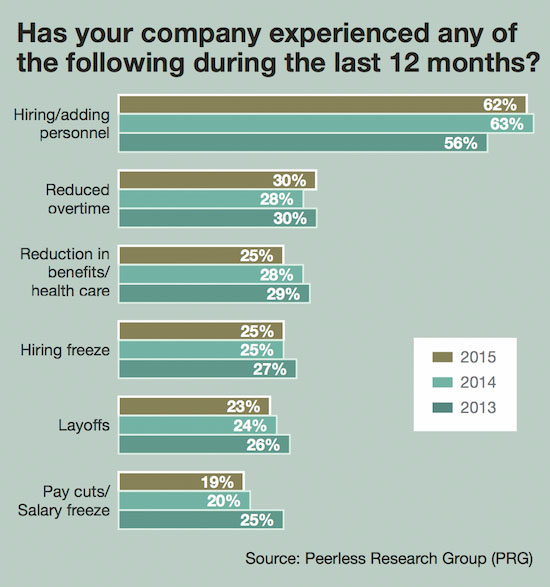
The 9% of respondents in company management (CEO, VP, GM, etc.) noted an 8% bump in compensation, to an average of $163,140, following last year’s 7% average salary increase. Conversely, the engineers who make up 19% of the survey base saw averages fall yet again to $88,840, shedding 2% after last year’s 10% loss. Compensation for plant management positions moved into six-figure territory last year, but has returned to 2013’s average of $88,000.
Those with supervisory responsibilities (75%) can expect to earn 13.6% more than their non-supervisor colleagues. The gap between the two was 23% last year, and has been steadily falling since a high of 36% in 2012. The average respondent with budgetary responsibilities oversees a spend of $200,000 (median: $16,000). They will earn about 25% more than those without budgetary authority, a gap that has also shrunk from last year’s 37%.

In the 2014 survey, the average supervisor salary slightly decreased and was met with a 2.6% increase in non-supervisor salaries. The trend has continued in 2015, as supervisor compensation fell slightly and non-supervisor salaries grew by 8%.
Average salaries are bucking historic trends in certain regions of the United States. In the Midwest, where 39% of respondents are located, salaries fell by about 3% from 2012 to 2013, only to spike by nearly 9% in 2014. This year the average is 1.3% higher at $97,240. In the mid-Atlantic region, home to 17% of respondents, the average salary jumped 6% to $102,235.
In the Southeast, where 14% of all respondents are employed, average salaries have returned to 2013 levels at $99,670 after an anomalous drop in 2014 to $87,300. Salaries in the South saw a big boost between 2012 and 2013, and held flat last year at about $92,000. In 2015, the South’s average added 6% to reach $97,350. In the West, where one in 10 respondents resides, average salaries shed more than 6%, the first decrease since 2012.
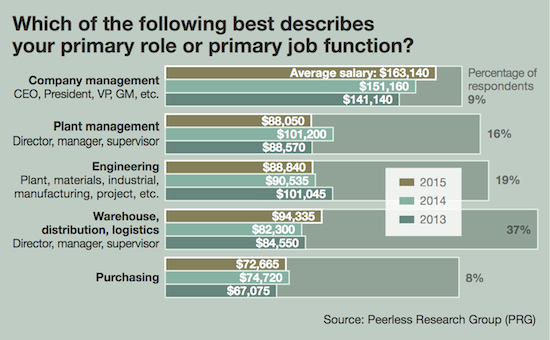
Job satisfaction
Once again, 16% of respondents express “extreme satisfaction” with their careers. The percentage of those “very” or “somewhat satisfied” shifted slightly to 56% and 26%, respectively. Today, only 1% are “not very” satisfied, and 1% are “not at all satisfied.”
This year, 32% of respondents indicate no interest in seeking another job, the lowest in five years. About 40% say they are “always open to other possibilities.” The same 20% as last year are passively looking for work elsewhere and the same 7% are actively looking. Those looking elsewhere are motivated primarily by compensation (61%), the desire for new challenges (40%), and a lack of advancement opportunities (38%).
When asked about stress levels at work, 45% say it is more stressful than two years ago, and 42% say stress levels have remained the same. Among the 10% who report their job is “extremely” stressful and the 32% whose work is “very” stressful, the top complaints included workload (48%), lack of staffing (45%), balancing work life and home life (40%), questionable management decisions (39%), lack of enough time to get the work done (37%) and working with outdated technologies (28%).
Respondents, by the numbers
In October 2015, Modern Materials Handling subscribers received an invitation by e-mail to participate in the annual salary survey. The e-mail included a dedicated URL linked to a Web site that hosted the questionnaire. The study, performed by Peerless Research Group, received a total of 401 responses from qualified materials handling professionals.
The average respondent earns $98,000 in salary, which is level with last year but up from less than $90,000 in 2012. Bonuses, on the other hand, have jumped to an average $24,010 from around $19,000 last year. Median salaries and bonuses have held level since last year’s survey.
The average respondent is a 46-year-old, a significant drop from the 51-year-old average the survey has indicated for at least the previous four years. He has worked with his company for about 10 years of his 17-year materials handling career, during which time he has worked for 2.5 companies. About 68% of respondents work for manufacturing companies. The average respondent works for a company with with 3,253 employees and an estimated annual revenue of $842 million.
In addition to an influx of young talent, females continue to hold a record 12% of materials handling positions. The average base salary for women also spiked from $73,560 in 2014 to $90,400, an increase of more than 20%. That number had dropped from $76,242 in 2011 to $66,635 in 2012 and only slightly more in 2013, but now stands at a record high.
Among respondents, 80% have been in the industry at least 10 years, 49% for more than 20 years, and 13% have been at it for more than 30 years, 5% less than in last year’s survey.
Only 7% of respondents were personally impacted by layoffs in the previous 12 months, which matches the record low of the last five years.

Article Topics
Latest in Logistics
A buying guide to outsourcing transportation management SKU vs. Item-level Data Visibility: Why it Matters for End-to-End Traceability Key benefits of being an Amazon Business customer with Business Prime USPS cites continued progress in fiscal second quarter earnings despite recording another net loss U.S. rail carload and intermodal volumes are mixed, for week ending May 4, reports AAR New Ryder analysis takes a close look at obstacles in converting to electric vehicles Norfolk Southern shareholders sign off on 10 board of directors nominees More LogisticsAbout the Author
Subscribe to Logistics Management Magazine

Find out what the world's most innovative companies are doing to improve productivity in their plants and distribution centers.
Start your FREE subscription today.
May 2024 Logistics Management

Latest Resources














